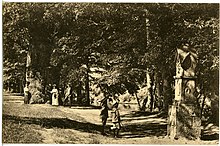Harrassage
The Harrassage is a jumping legend from the Saxon Zschopau valley . Today it is ascribed to the knight Diedrich von Harras .
The following version of the legend is taken from the legend book of the Kingdom of Saxony by Alfred Meiche . The orally transmitted legend was first published on July 4th, 1801 in the Chemnitzer Anzeiger . In it rider and horse came unharmed on the bank. Theodor Körner , who in 1810 wrote his famous ballad Harras, the bold jumper sitting under the Harra oak , must have known this article, but he described that the horse drowned in the water. Since then the legend has been mentioned in numerous legends, even in the legends of the Brothers Grimm . People have often thought about the origin of the legend. In the rather boring hilly landscape, high and bizarre rocks and deep valleys would stand out and encourage bold thoughts. This was linked to historical events and a number of so-called leap sagas were created .


legend
Knight Dietrich von Harras sat at Lichtenwalde Castle in the 15th century . The good relationship with the owner of the Schellenburg had been clouded by some influences and brought enmity between the two. Harras was unmarried, and he had fallen in love with Luitgard, the Schellenberger's beautiful daughter. All attempts at reconciliation were in vain. The enmity grew.
One day a squire brought the message to the knight Götz that in a few hours Harras and his squires would be going to the mouth of the Flöh to await visitors. The plan was quickly made to overwhelm the hated enemy there. Götz went to Flöha and hid himself with his knights in the forest. The joy was great when Harras unsuspectingly rode up. The enemy riders were already breaking out of the forest. Harras turned his horse around in a flash and blasted into the forest while his squires turned on the enemy. Soon they were dead or wounded on the ground and the pursuit began. Harras could already hear the pursuers behind him. Then he saw a clear spot in the forest. It was the stone of the house. His castle was over there, deep below him the waters of the Zschopau flowed, and behind him the enemies appeared - nowhere a way out! What should he do? In the greatest need Harras recommended his soul to God, spurred his shy horse, and descended into the dreadful depths. The daring leap succeeded. The steed died, but Harras was unharmed. He swam to the other bank and thanked God. This happened in 1449 . Incidentally, the imprint of the horseshoe of a rearing horse is said to still be visible in the rock today. The wonderful rescue and the requests of Luitgard are said to have moved Götz to consent to a reconciliation. Both Luitgard and Harras then lived long and happily together.
Harras then went on a pilgrimage to the Ebersdorf collegiate church . In memory of the happy rescue he left a silver horseshoe there . His son Georg II von Harras is said to have exchanged this for an iron one in 1529.
The people on the Schellenburg who were associated with the legend probably never existed. It is also not known that Dietrich was married to a Luitgard.
Today the Harrasfelsen can be climbed from the west via an incline with 111 steps. From the east, another hiking trail leads a little flatter here.
literature
- The middle Zschopau area (= values of our homeland . Volume 28). 1st edition. Akademie Verlag, Berlin 1977, pp. 35-39.


